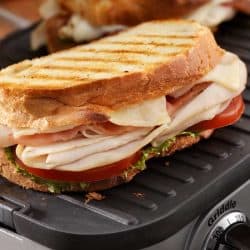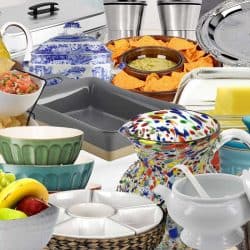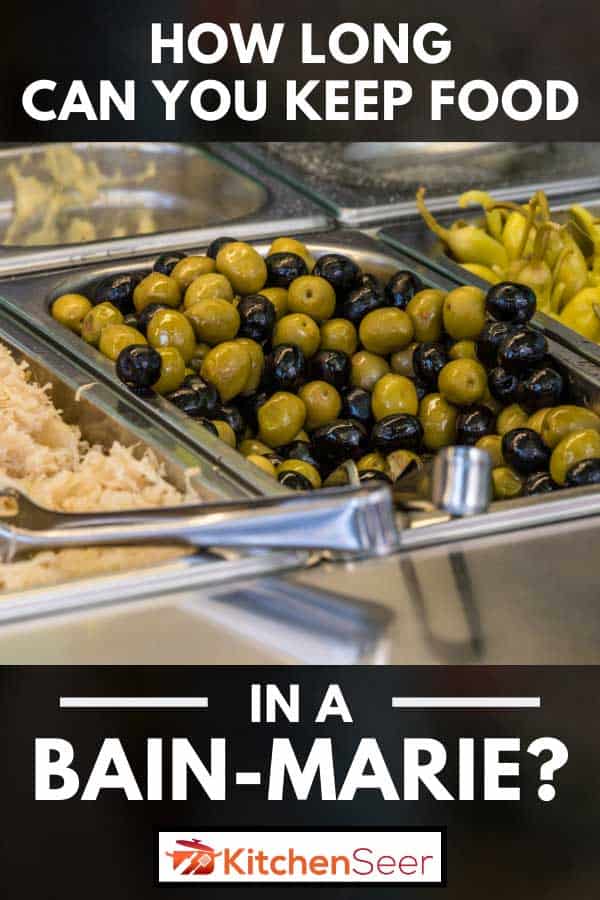 Keeping cooked food warm in a bain-marie is a common technique among the foodservice industry. But you can use this handy food service method at home too. Serve up something new for your weekend routine by preparing a brunch buffet. If you are wondering how long you can keep food in a bain-marie, we’ve done the research on serving food safely to get the answer for you.
Keeping cooked food warm in a bain-marie is a common technique among the foodservice industry. But you can use this handy food service method at home too. Serve up something new for your weekend routine by preparing a brunch buffet. If you are wondering how long you can keep food in a bain-marie, we’ve done the research on serving food safely to get the answer for you.
Food kept at a consistent temperature, either hot or cold, can be kept safely in a bain-marie for up to 4 hours.
The delicious uses of a bain-marie do not need to stop at brunch. In fact, this appliance can be a handy and festive addition to your kitchen. Keep reading to learn the temperature ranges necessary to prevent bacteria growth when you keep food warm using a bain-marie.
How Do You Keep Food Warm In A Bain Marie?
A bain-marie, or hot water bath, keeps food warm by using hot water to indirectly transfer heat. It involves using two containers. A food pot/tray is placed into a larger base pot/tray. Hot water fills the base pot/tray until the level of water is about half-way up the sides of the food pot/tray.
Covering the bain-marie with a lid or foil keeps food moist. The idea is to keep food warm, yet prevent it from overcooking or drying out. Water is kept at temperature by applying direct heat to the base pot/tray.
Most bain-marie set-ups are standalone, using either gas or electric heating elements. The food pots/trays range in size, as does the base to accommodate soups, sauces, and entrees. A bain-marie can either sit on a countertop or demand its own space as an integrated tabletop.
Click here to find this electric bain-marie on Amazon.
How Can I Set-Up A Bain Marie At Home?
You can change up your dinner menu when you make a DIY bain-marie at home using your own pots/trays. Keep soup warm as an appetizer while you prepare the night’s entree. You can keep the food warm either in the oven or on the stovetop.
Make sure all of your pots, trays, or bowls that you use are stovetop and oven safe. For bowls, Pyrex dishes, and stainless steel mixing bowls all work well.
If you do prefer to use the oven, you should remember to cover the bain-marie set-up with foil in order to prevent the food from drying out. A cover will trap steam from the boiling water in the base pot and keep food moist.
Serving a larger menu usually requires a commercially made bain-marie. This is a great technique to use on Super Bowl Sunday so all of your food will stay warm while you watch the game.
Click here to find this electric bain-marie on Amazon.
You can purchase a bain-marie at a local restaurant supply store, Amazon, or Walmart. For a one-time occasion, consider renting a bain-marie from a local restaurant supply store or party rental store.
Click here to find this 3-section bain-marie by Sybo at Walmart.com
What Temperature Should A Bain-Marie Be Kept At?
Water temperature is an important factor when using a bain-marie because the food will stay the same temperature as the water. As a cooking technique, the bain-marie heats gently and evenly throughout the entire dish.
Temperature For Warming
To keep food warm, the water should remain at a constant, minimum temperature of 140°F (60°C). This will ensure that the food stays at least 135°F (57°C) throughout, too hot for bacteria to grow.
The USDA recommends keeping food in a bain-marie, or “hot holding,” for a maximum of 4-hours at 130°F. However, a maximum of 8-hours can be achieved if food remains at 140°F.
Since it is difficult to maintain a consistent food temperature, we suggest you err on the side of caution to keep food safe by removing from the bain-marie after between 2-4 hours of serving.
Temperature For Cooking/Baking
To cook, bake, or melt foods using the bain-marie, the water is typically kept boiling at 212°F (100°C).
The duration will vary per recipe as to how long to cook or bake foods using a bain-marie. Melting involves constant monitoring and is finished when the texture throughout is smooth.
What Is The 2 Hour/4 Hour Rule?
The 2-hour/4-hour rule is a scientifically based method used to standardize food service. It is used for both hot foods and cold foods.
Basically, food cannot remain in the “danger zone” where bacteria is likely to grow, at room-temperature range (40°F - 140°F), for longer than 2 hours at a time. Food that has been out for 2 hours must be immediately refrigerated and should be reheated prior to serving.
If food has been kept at room temperature for a cumulative time of 4 hours or longer, it should be thrown away. This means all of the prep time necessary is included in the overall timeframe. So, each time food is removed from the refrigerator to be prepared, warmed, and served, that time should be included in the cumulative “danger zone” time for the 2-hour/4-hour rule.
For even more great tips on how to serve food check out our post How Big Should a Serving Bowl Be?
What Is The Difference Between Wet And Dry Bain-Marie?
As you might have already guessed, the difference between a wet and dry bain-marie is water. Let’s take a closer look at both techniques and how each can be beneficial for keeping food warm.
Wet Bain Marie
The traditional bain-marie uses wet heat to gently cook food or bathe food in hot water. The food does not come into direct contact with hot water. Heat is transferred indirectly by boiling water surrounding the pot that holds the ingredients.
Click here to find this on Amazon.
The wet system is beneficial to keeping consistency throughout the food because:
- The water temperature cannot exceed the boiling point to risk overcooking or burning the food.
- Using a lid to contain steam also keeps food moist.
When preparing or warming food by using a wet bain-marie, use caution because boiling water and steam created atop the water can cause burns. Let the bain-marie cool before cleaning.
Dry Bain Marie
A dry bain-marie does not use water. Instead, dry heat is applied using a modern electric heating element to heat the area beneath the pot that holds the ingredients to be cooked. Similarly to a wet bain-marie, the technique is indirect.
Click here to find this on Amazon.
The dry system is advantageous particularly in the foodservice industry because:
- It is safer, by eliminating the risk of burns from boiling water or steam.
- It heats rapidly.
- It is energy efficient.
When preparing and warming food by using a dry bain-marie, adjust the temperature carefully and observe the food so that it does not burn or stick to the bottom of the pot/tray. Dry heat can get hotter than water’s boiling temperature.





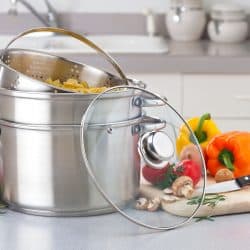
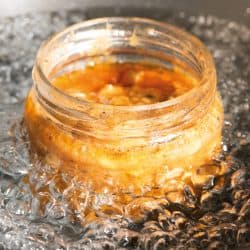
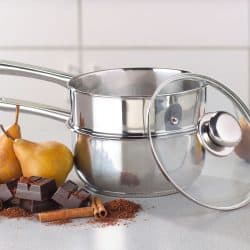
![Kitchen utensils in containers on table, Kitchen Utensils: The Ultimate List [Do You Know All 56?]](https://kitchenseer.com/wp-content/uploads/2020/05/Kitchen-utensils-in-containers-on-table-250x250.jpg)
